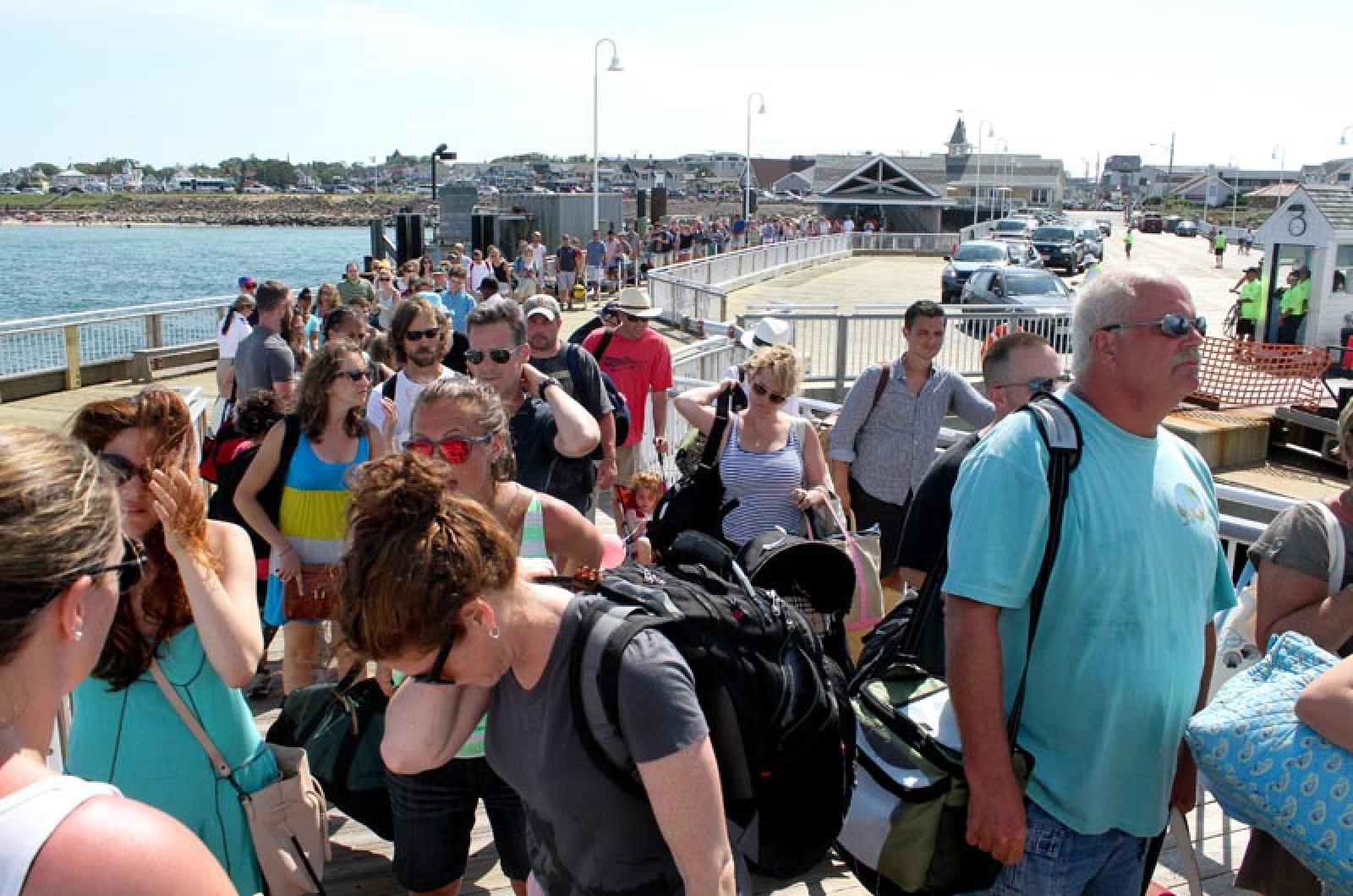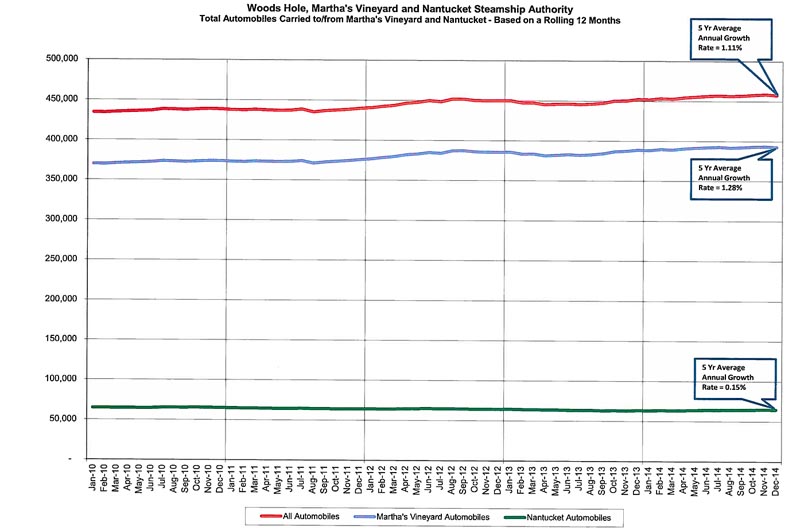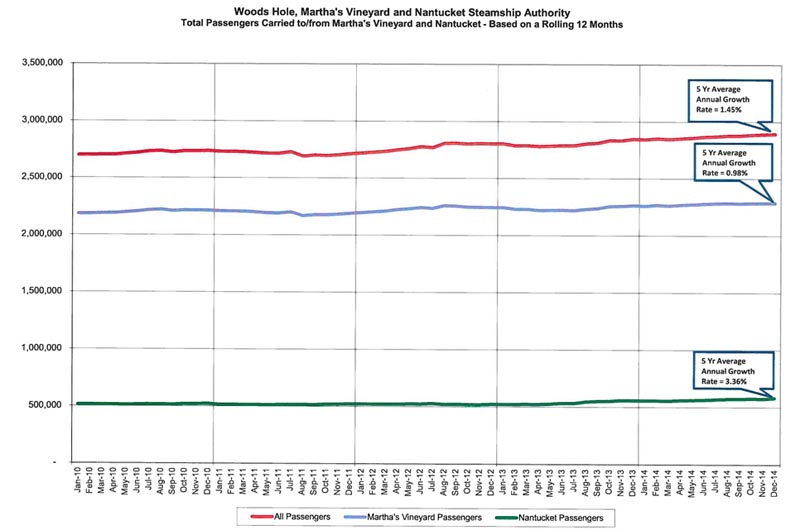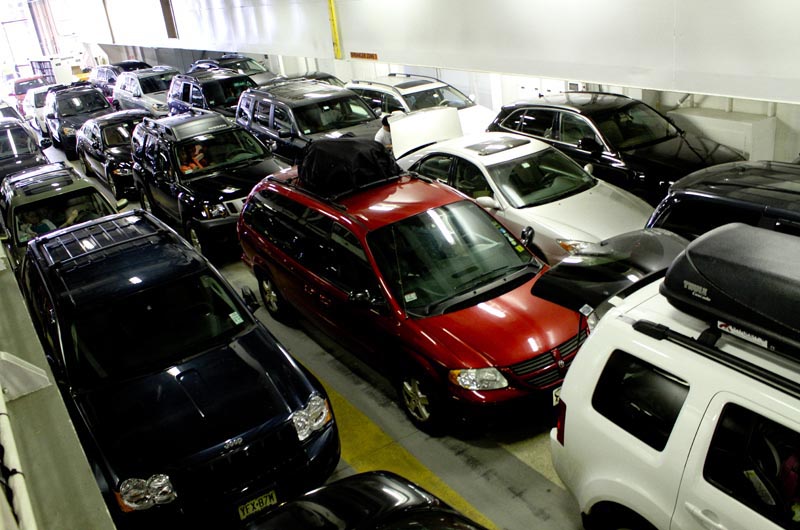While it may feel like more cars flood Martha’s Vineyard each year, new data released by the Steamship Authority tell a different story.
“The traffic has been pretty flat,” SSA general manager Wayne Lamson told the Gazette this week. “We are hearing about all the increased traffic on both ends and yet the numbers just don’t bear that out.”
Graphs released by the boat line this week show that over the past five years, traffic aboard the ferries that serve the Vineyard have seen very slight annual gains.
Passenger and truck traffic on the Vineyard route has seen average gains of just 1 per cent since January 2010, while the number of cars carried advanced an average of 1.3 per cent per year.
The graphs show trends in passage to both Islands over a five-year period and plot totals recorded each month for the previous 12-month period.
Travel rates to sister island Nantucket tell a similar story.
On the Nantucket route, car traffic is up only 0.15 per cent, while truck traffic saw gains of around 2 per cent.
The largest gains were seen among passengers traveling on the Nantucket route, where the annual growth rate has been calculated at 3.4 per cent.
Overall, passenger traffic on both routes had an average annual growth rate of 1.45 per cent, while cars were up 1.1 per cent.
“It kind of looks like the patient has expired, if this was a heart monitor,” Mr. Lamson said, describing the graphs.
Meanwhile, both Islands have seen some gains in the year-round population. In 2010, the census counted 16,535 Dukes County residents, and in 2013, estimated it at 17,256.
In Nantucket County, the census had 10,146 in 2010 and an estimate of 10,399 in 2013.
The five-year report offers only a snapshot of growth aboard the Steamship Authority. But analyzing the same traffic data over a 10-year period proved difficult because the SSA has since changed the way it classifies trucks. If he had to guess, Mr. Lamson said he would say boats were busier in the years before the recession, though there is no strict data to back it up.
The graphs do not show trends specific to the summer season, but in recent years, the SSA has reported comparable gains from one peak season to the next.
Though she had not seen the charts, chamber of commerce director Nancy Gardella said she was a little surprised by a report of slow growth in traffic to the Vineyard, but added that the Steamship’s marketing team had been working hard to promote the Island.
“We sit poised on a world stage competing with not only our neighbors of Cape Cod, Nantucket and Newport, we are also competing with much bigger destinations that are investing a ton of tourism and marketing dollars,” she said. “Quite frankly, we are one of the few destination chambers that receives absolutely no funds from the towns and the county.”
Her organization, which receives state funding, has been working to expand tourism in the fall and spring seasons. Over the eight years she’s been at the chamber, she said Columbus Day has increasingly replaced Labor Day as the end of the summer season.
In that same period, her full-time staff has dropped from nine to four employees with state budget cuts.
“Our goal is to stimulate a healthy Island economy, so we would love to work more closely with all partners, including the ferry service and the towns and the county,” Ms. Gardella said.“I think we are doing a good job, and I think we could do better.”
A trend of slow growth may also come as a surprise to Islanders and Woods Hole residents who have voiced concerns that their port towns are experiencing increasing congestion.
As the SSA prepares to finance several large capital projects, questions have been raised about the scale of some of them, including a planned $40 million dollar freight ferry that will be built and a project to rebuild the Woods Hole terminal, which recent estimates put at $61.7 million.
“The expansion of the line has been really unchecked,” said Marie Laursen, a Vineyard Haven resident who complained of severe traffic congestion in her community at the monthly SSA board meeting in Woods Hole this week. In a letter to the Steamship Authority, West Tisbury resident Virginia Jones described the ferry and terminal projects as “hugely costly and ambitious projects” that represented a departure from the boat line’s original mission to provide reliable transportation to Islanders.
“In spite of [Mr. Lamson’s] firm hand on the reins (or perhaps he is complicit) the tendency to grow and expand has, unfortunately increased,” Mrs. Jones wrote in part. The letter is published as a letter to the editor in today’s edition.
For his part, Mr. Lamson said there wasn’t a lot of expansion in the works.
He said the new terminal in Woods Hole will be about the same size as the Vineyard Haven terminal, though it must be elevated out of the flood zone.
He also said that the freight ferry Governor, a 60-year-old vessel, needs to be replaced. He compared it to an old car.
“You start to put money into it and it gets to the point where is it more economical in the long run to buy a new car,” Mr. Lamson said. “Looking long term, people have to understand the need to be constantly upgrading the fleet and not falling too far behind.”
The Governor has limited utility and can only operate on the Vineyard route, whereas the new ferry will ply both routes.
In her testimony, Mrs. Laursen pointed to advertising, among other factors, as being responsible for the “unfettered numbers of cars” coming to the Island, which she said had an impact on quality of life.
“The Steamship does a lot of advertising so you are creating the demand and using it as a basis to create business,” she said.
Each year, the SSA spends about $1 million on advertising.
Mr. Lamson said the boat line promotes the Islands in connection with the chamber of commerce.
“You need to be out there letting people know that you are here and you are providing that service,” he said. “We don’t consider it mission creep, we consider it part of our service . . . it’s all part of trying to pay the bills, and cover the expenses.”
Robert R. Jones, the Barnstable member of the Steamship Authority Port Council, made a similar comment at the meeting this week.
“This is a big economy, and it runs the Islands,” he said. “They need this tourism to survive the year.”









Comments (13)
Comments
Comment policy »